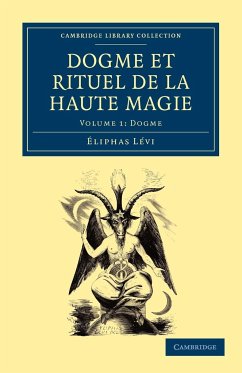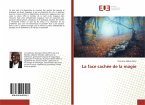Éliphas Lévi
Dogme et Rituel de la Haute Magie - Volume 1
Éliphas Lévi
Dogme et Rituel de la Haute Magie - Volume 1
- Broschiertes Buch
- Merkliste
- Auf die Merkliste
- Bewerten Bewerten
- Teilen
- Produkt teilen
- Produkterinnerung
- Produkterinnerung
Written in 1854, this two-volume treatise on the occult explains the philosophy and method of ritual magic.
Andere Kunden interessierten sich auch für
![Les racines transrationnelles de la science - Tome VI Les racines transrationnelles de la science - Tome VI]() Sekou SanogoLes racines transrationnelles de la science - Tome VI68,99 €
Sekou SanogoLes racines transrationnelles de la science - Tome VI68,99 €![La face cachée de la magie La face cachée de la magie]() Ousmane Jibhala KéitaLa face cachée de la magie28,99 €
Ousmane Jibhala KéitaLa face cachée de la magie28,99 €![Créer la ville Créer la ville]() Fiorenza GambaCréer la ville31,00 €
Fiorenza GambaCréer la ville31,00 €![LE RITE DE TSIKAFARA EN PAYS TSIMIHETY LE RITE DE TSIKAFARA EN PAYS TSIMIHETY]() TOTOVAHINY Bellarmin NicodèmeLE RITE DE TSIKAFARA EN PAYS TSIMIHETY43,99 €
TOTOVAHINY Bellarmin NicodèmeLE RITE DE TSIKAFARA EN PAYS TSIMIHETY43,99 €![Le propre livre du magicien ou tout l'art de la conjuration étant un manuel complet de magie de salon , et contenant plus de mille expériences optiques, chimiques, mécaniques, magnétiques et magiques, des transmutations amusantes, des tours et subtilité Le propre livre du magicien ou tout l'art de la conjuration étant un manuel complet de magie de salon , et contenant plus de mille expériences optiques, chimiques, mécaniques, magnétiques et magiques, des transmutations amusantes, des tours et subtilité]() George ArnoldLe propre livre du magicien ou tout l'art de la conjuration étant un manuel complet de magie de salon , et contenant plus de mille expériences optiques, chimiques, mécaniques, magnétiques et magiques, des transmutations amusantes, des tours et subtilité27,99 €
George ArnoldLe propre livre du magicien ou tout l'art de la conjuration étant un manuel complet de magie de salon , et contenant plus de mille expériences optiques, chimiques, mécaniques, magnétiques et magiques, des transmutations amusantes, des tours et subtilité27,99 €![Néolithisation et Diversités culturelles dans la Haute Mésopotamie Néolithisation et Diversités culturelles dans la Haute Mésopotamie]() Ergül KodasNéolithisation et Diversités culturelles dans la Haute Mésopotamie32,99 €
Ergül KodasNéolithisation et Diversités culturelles dans la Haute Mésopotamie32,99 €![Sorcellerie Sorcellerie]() Sorcellerie38,99 €
Sorcellerie38,99 €-
-
-
Written in 1854, this two-volume treatise on the occult explains the philosophy and method of ritual magic.
Hinweis: Dieser Artikel kann nur an eine deutsche Lieferadresse ausgeliefert werden.
Hinweis: Dieser Artikel kann nur an eine deutsche Lieferadresse ausgeliefert werden.
Produktdetails
- Produktdetails
- Verlag: Cambridge University Press
- Seitenzahl: 392
- Erscheinungstermin: 19. Mai 2011
- Französisch
- Abmessung: 216mm x 140mm x 23mm
- Gewicht: 551g
- ISBN-13: 9781108027526
- ISBN-10: 1108027520
- Artikelnr.: 33114342
- Herstellerkennzeichnung
- Libri GmbH
- Europaallee 1
- 36244 Bad Hersfeld
- gpsr@libri.de
- Verlag: Cambridge University Press
- Seitenzahl: 392
- Erscheinungstermin: 19. Mai 2011
- Französisch
- Abmessung: 216mm x 140mm x 23mm
- Gewicht: 551g
- ISBN-13: 9781108027526
- ISBN-10: 1108027520
- Artikelnr.: 33114342
- Herstellerkennzeichnung
- Libri GmbH
- Europaallee 1
- 36244 Bad Hersfeld
- gpsr@libri.de
Éliphas Lévi (1810-1875) was the pseudonym used by Alphonse-Louis Constant after 1853, around the time he first published Doctrine and Ritual. An artist, poet, political activist and writer, and in his later years of life, occultist, here was a man who helped to fuel the occult revival and focused interest on spiritualism that swept through the Western world during the French Revolution and which would endure until the World Wars. Constant was born into a poor working-class family, the son of a shoemaker. However, he demonstrated prodigy and high intellect from a young age, which inspired the priest of his local parish to send Constant to the Society of Saint Sulpice for a free seminary education where the boy learned Greek, Latin, and Hebrew. In his childhood, Constant tended to be a solitary child, more interested in drawing and painting. Later he would manage to support himself by selling his art. Though he entered the seminary on a track to priesthood, he was later compelled to drop out due to an alleged affair with an underage female student and his incompatible theological beliefs that were growing at odds with the Church. Throughout his 20s and 30s, Constant was a radical socialist, a form of extreme left liberal political ideology of his time. He attributed his political leanings to his Christian love of humanity, in spite of such leanings tending to run contrary to the Church. While devoted to his faith, Constant was also critical of the Church, and spoke out against its conservative views on sexuality and its denigration of women. In 1841, he was thrown in jail for his incendiary journalism and political activism. At trial, he made the following statement: "As a child of the people, I have suffered with the people and have dared to speak in the name of the people . . . . My only crime has been a deep love of mankind." Fellow Socialist activists, however, didn't quite understand him. While they supported his radical left political writings, they said this about him: "You possess devotion and energy, but you are mistaken when you speak to us of God, Spirit, and Love. We know only nature and matter." During this time he also co-authored The Emancipation of Women with Flora Tristan (1803 - 1844), a feminist, socialist, writer, and outspoken champion for the working class. By 1848, Constant was thrown in jail yet again for his socialist politics. By his late 30s, Constant switched from politics to occultism and at the age of 46, published what would become his masterpiece, Dogme et Ritual de la Haute Magie under the pen name Éliphas Lévi. However, he never fully gave up politics, as his political writings had him incarcerated in 1855, the interim year between the publication of Doctrine and Ritual. After Doctrine and Ritual, he published the History of Magic in 1860 when he was 50 and then Key to the Great Mysteries in 1861. For much of his life, he struggled financially, was sedentary and introverted, and spent most of his time pent up in his small rented Parisian apartment. "Newton leads us back to Pythagoras," he said famously. Thematic across all of his occult works would be the proposition that magic is a science, that science itself inherits a legacy of occult traditions, and for any religion to be true, it must agree with philosophy. Edited from Benebell Wen
Discours préliminaire
Introduction
1. Le récipiendaire
2. Les colonnes du temple
3. Le triangle de Salomon
4. Le tétragramme
5. Le pentagramme
6. L'équilibre magique
7. L'épée flamboyante
8. La réalisation
9. L'initiation
10. La cabale
11. La chaîne magique
12. Le grand oeuvre
13. La nécromancie
14. Les transmutations
15. La magie noire
16. Les envoûtements
17. L'astrologie
18. Les philtres et les sorts
19. La pierre des philosophes
20. La médecine universelle
21. La divination
22. Résumé et clef générale des quatre sciences occultes.
Introduction
1. Le récipiendaire
2. Les colonnes du temple
3. Le triangle de Salomon
4. Le tétragramme
5. Le pentagramme
6. L'équilibre magique
7. L'épée flamboyante
8. La réalisation
9. L'initiation
10. La cabale
11. La chaîne magique
12. Le grand oeuvre
13. La nécromancie
14. Les transmutations
15. La magie noire
16. Les envoûtements
17. L'astrologie
18. Les philtres et les sorts
19. La pierre des philosophes
20. La médecine universelle
21. La divination
22. Résumé et clef générale des quatre sciences occultes.
Discours préliminaire
Introduction
1. Le récipiendaire
2. Les colonnes du temple
3. Le triangle de Salomon
4. Le tétragramme
5. Le pentagramme
6. L'équilibre magique
7. L'épée flamboyante
8. La réalisation
9. L'initiation
10. La cabale
11. La chaîne magique
12. Le grand oeuvre
13. La nécromancie
14. Les transmutations
15. La magie noire
16. Les envoûtements
17. L'astrologie
18. Les philtres et les sorts
19. La pierre des philosophes
20. La médecine universelle
21. La divination
22. Résumé et clef générale des quatre sciences occultes.
Introduction
1. Le récipiendaire
2. Les colonnes du temple
3. Le triangle de Salomon
4. Le tétragramme
5. Le pentagramme
6. L'équilibre magique
7. L'épée flamboyante
8. La réalisation
9. L'initiation
10. La cabale
11. La chaîne magique
12. Le grand oeuvre
13. La nécromancie
14. Les transmutations
15. La magie noire
16. Les envoûtements
17. L'astrologie
18. Les philtres et les sorts
19. La pierre des philosophes
20. La médecine universelle
21. La divination
22. Résumé et clef générale des quatre sciences occultes.








